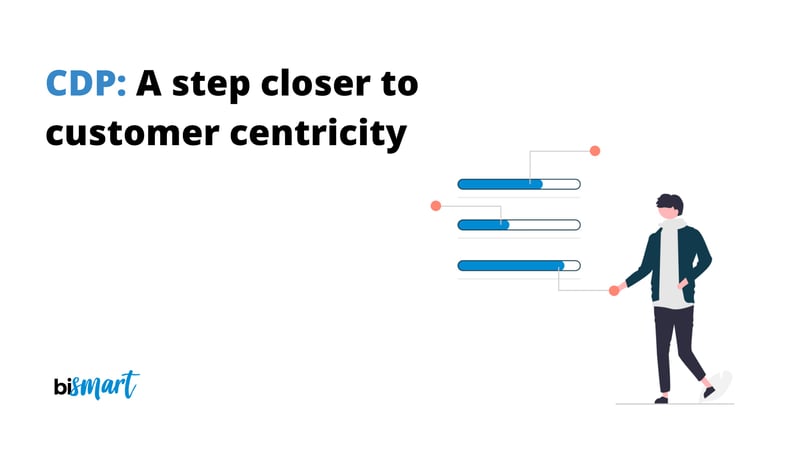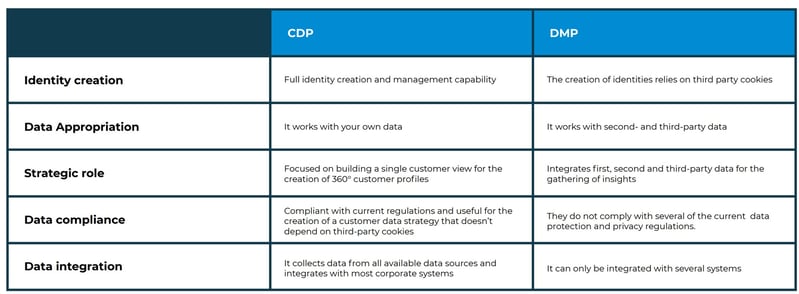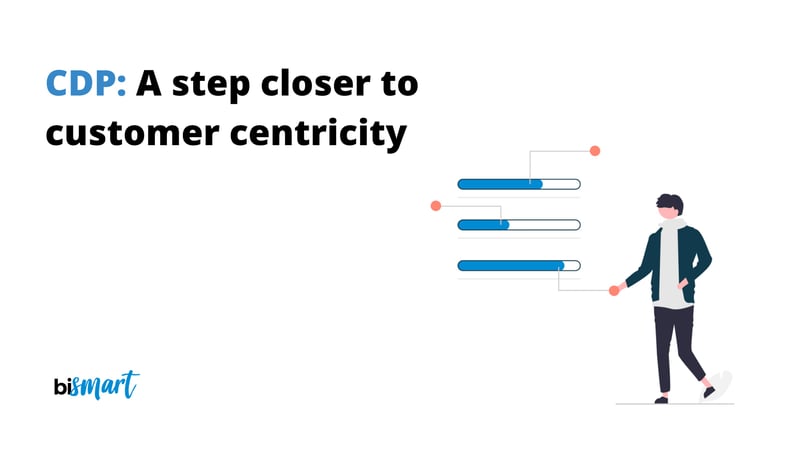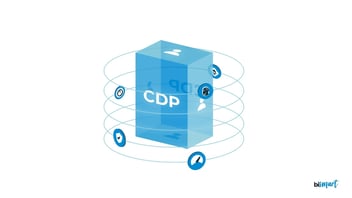We explore the differences between a Customer Data Platform, a Data Management Platform and CRM systems. Don't miss our exclusive e-book on CDP!
Customer data fragmentation has become businesses' greatest enemy. Traditional customer data management technologies can no longer meet new business needs. We explore the differences between a Data Management Platform and a Customer Data Platform (CDP), an emerging technology that promises to replace DMPs.

"A new technology appears, seemingly from the ether, and promises to change our lives. Customer data integration, labelling and storage problems will disappear. Identities will merge. You’ll be able to find new audiences until your ribs squeak and deliver them to any execution system in the barn. Oh, and it will scale, rarely fail and enable (yes) true one-to-one marketing. The name of this magic machine is … CRM. It was 1998. Companies piled in, dropping $3.5 billion a year on apps and databases alone – consulting fees not included – and yet, by 2001, 50% of CRM projects “failed.” The same thing happened, on a lesser scale, during the great marketing automation boom of the 2000s."
This is how Gartner described in 2018 the failure of most CRM systems which, despite having made customer relationship management easier, have not managed to solve companies' biggest problem: the fragmentation of customer data. The same has happened with the technology that promised to replace CRMs: Data Management Platforms (DMPs).
While it is true that Data Management Platforms have succeeded in overcoming some of CRMs' limits by solving, for example, the creation of audiences, they have also perpetuated data fragmentation.
It has not been until the emergence of the Customer Data Platform (CDP) that the real solution to the problem has been found.
What's CDP's secret and why is it the technology that market-leading companies are investing in the most? Find out everything you need to know about the Customer Data Platform in our free e-book: "CDP: A step closer to customer centricity".
Data fragmentation: The 'Achilles' heel' of customer strategies
Customer data fragmentation is one of the most important reasons why companies are still failing to implement a customer centric and data-driven culture.
In 2017, Gartner released research that asked a large group of executives why they were failing to implement a customer-centric perspective. 52% of respondents argued that fragmented silos prevent them from sharing customer data and 33% mentioned that their company does not have the technologies in place to properly manage customer data.
In today's business ecosystem, customer data is separated into fragmented and often incompatible silos, producing multiple segments of information about the same customer. On the one hand, this prevents companies from harnessing the potential of data and making data-driven decisions and, on the other hand, it makes it impossible to obtain a unified view of the consumer and create 360º customer profiles. This is also the reason why companies spend more time processing data than analysing and exploiting it to optimise business operations.
However, all is not lost. An issue that has hampered customer strategies for decades can be easily solved with an emerging data integration technology: the Customer Data Platform, a customer relationship management system that centralises data collection and consumer data integration processes, bringing data together in a single repository that allows companies to create 360° customer profiles and run integrated campaigns across all channels and touchpoints.
Customer Data Platform vs. Data Management Platform (DMP): Differences, scope and opportunities
CDP was born to solve the limitations of other customer relationship management systems, especially Customer Relationship Management (CRM) and Data Platform Management (DMP).
The main difference between a CRM and a Customer Data Platofrm is that CRMs focus on the collection of transactional and sales data from existing customers. That is, it provides information on clients’ movements and transactions, but it doesn’t provide insights about anonymous users who interact with our touchpoints but don’t make a purchase. CRM systems are only useful for existing customers but are not designed to collect and integrate data from unidentified users.
As for Data Management Platforms (DMPs), the main difference between the two technologies is their approach. DMPs are designed for the creation and optimisation of audiences and, therefore, data is collected with a clear intention of distributing advertising content. In fact, the vast majority of Data Management Platforms have a marketplace for the purchase of third party data.
A Data Management Platform is unable to build a complete customer profile, as it only unifies data related to advertising. The Customer Data Platform (CDP), on the other hand, is able to centralise the total consumer data for the construction of 360° customer profiles.
Moreover, DMP platforms cannot create different types of user attributes (numerical attributes, qualitative attributes, dates, etc.), but CDPs can. This means that, with a DMP, we cannot cross-reference customer data with relevant contextual data such as price fluctuations, currency, location, weather conditions or stock market data to name a few.
Beyond the approach, Data Management Platforms and Customer Data Platforms have different technical functionalities:

In short, Customer Data Platforms (CDP) go one step beyond CRMs and DMPs, being precisely designed to fill the gap in customer management left by Enterprise Data Warehouses, CRM systems, Data Management Platforms and Master Data Management (MDM). Not even all these systems combined meet today’s companies customer relationship management needs.
Conclusion
The consolidation of the Customer Data Platform brings us into a new era where building unique and complete customer insights, fully managing audiences, developing optimal and consistent personalisation strategies and generating the right message for each channel and touch point is not only possible, but also easy and automatic.
No technology happens by chance. Technological advances come from necessity and, for the first time, we are faced with a tool whose appearance has been prompted both by customers’ and companies’ needs. Consequently, companies reluctant to explore the advantages of this new technology will not only be missing out, but they will also be preventing their clients from higher value.
In this article we have briefly described some of the reasons why CDP is positioning itself as a key technology in the business world. However, you will find more detailed information on its capabilities, scope, use cases, impact areas and future trends in our E-book: CDP: A step closer to customer centricity Don't miss it!



